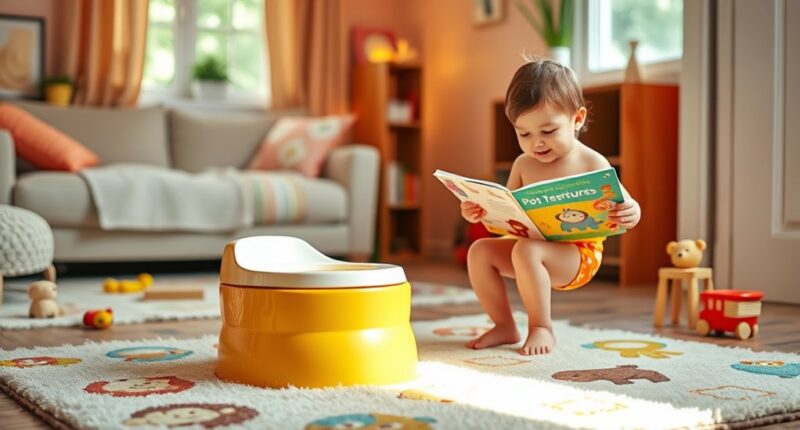Potty training usually starts between 18 and 30 months. Look for signs of readiness like staying dry longer and showing interest in the potty. Create a supportive environment with a potty chair, establish a routine, and make it fun using books or dolls. Consistency and positivity are key, but don’t rush if your child isn’t ready. If you follow these guidelines, you’ll help make the process smoother and easier for both of you. There’s much more to explore about this!
Key Takeaways
- Start potty training between 18 and 30 months, with most children fully trained by age 4.
- Create a potty-friendly environment and establish a consistent routine for visits.
- Look for signs of readiness, such as staying dry longer and expressing needs verbally.
- Use engaging tools like potty training books and dolls to make learning fun.
- Be patient and supportive, addressing any fears or anxieties your child may have.
Understanding the Right Age to Begin Potty Training
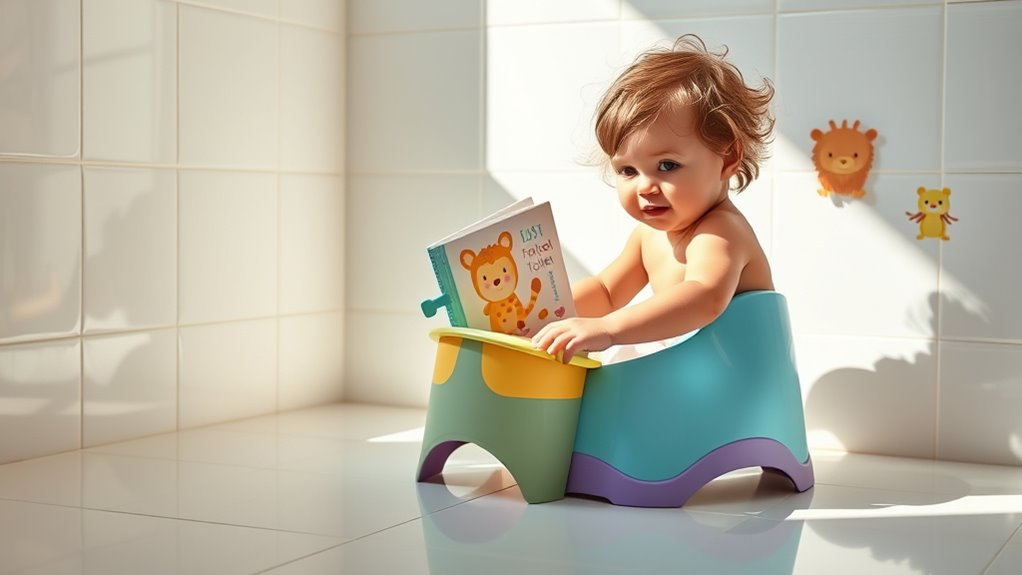
When should you start potty training your child? The average age in the U.S. is between 2 and 3 years old, with most kids fully trained by age 4.
You’ll find many children beginning to train between 18 and 30 months, but remember that boys often take longer than girls.
Factors like developmental readiness, emotional signs, and physical abilities are essential. You shouldn’t rush this process; starting too early might lead to frustration for both of you.
Look for signs like staying dry for two hours, showing interest in the toilet, or communicating their needs.
Each child is unique, so be patient and responsive to their individual readiness cues.
Preparing Your Child for Potty Training
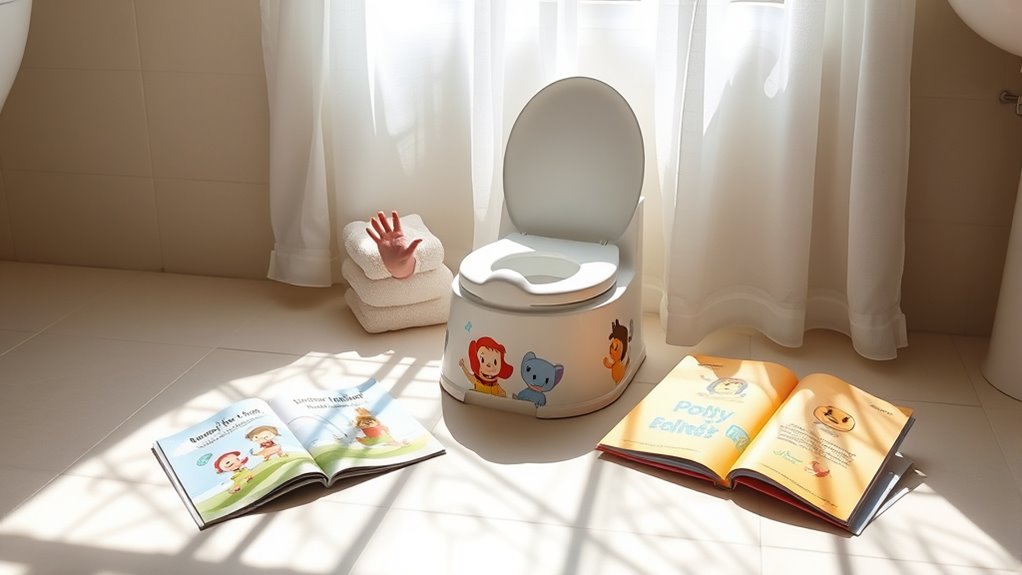
To guarantee a smooth potty training experience, it’s essential to prepare your child both emotionally and physically. Start by creating a potty training environment with a potty chair in familiar spaces, so they see it often.
Establish a consistent routine, taking them to the potty after meals or drinks. Use simple, positive language to describe bodily functions, helping them understand the process.
Establish a routine by guiding them to the potty after meals, using positive language to foster understanding.
Consider introducing engaging tools like potty training books or a self-wetting doll. Encourage body awareness by modeling toilet use and communicating needs.
Finally, gradually introduce potty use by having them sit on the potty with clothes on, then progress to minimal clothing, boosting their confidence along the way.
Recognizing Signs of Readiness
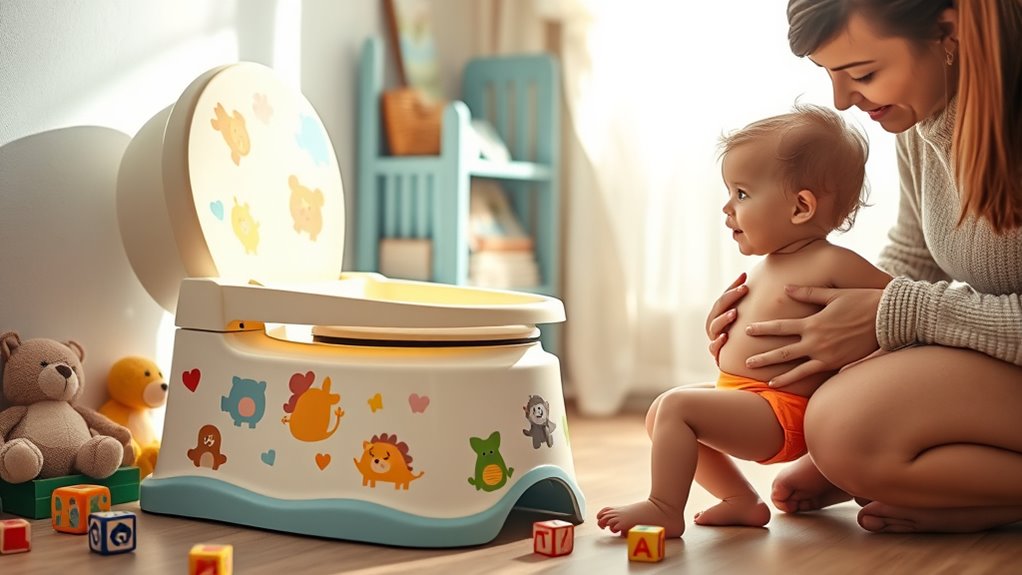
Recognizing the signs of readiness for potty training is crucial for a successful change. Look for physical indicators like your child staying dry for longer periods or having predictable bowel movements. If they wake up dry from naps or can sense the urge to go, these are promising signs.
Developmentally, your child might imitate others using the potty or follow simple instructions. They should also express their needs verbally and manage their clothes.
Behaviorally, if they show interest in the potty or announce when they need to go, this indicates readiness.
Finally, emotional signs such as enthusiasm to please and having coping skills for accidents are key. Guarantee your home environment is stable to support the process.
Steps to Practice Potty Training Effectively
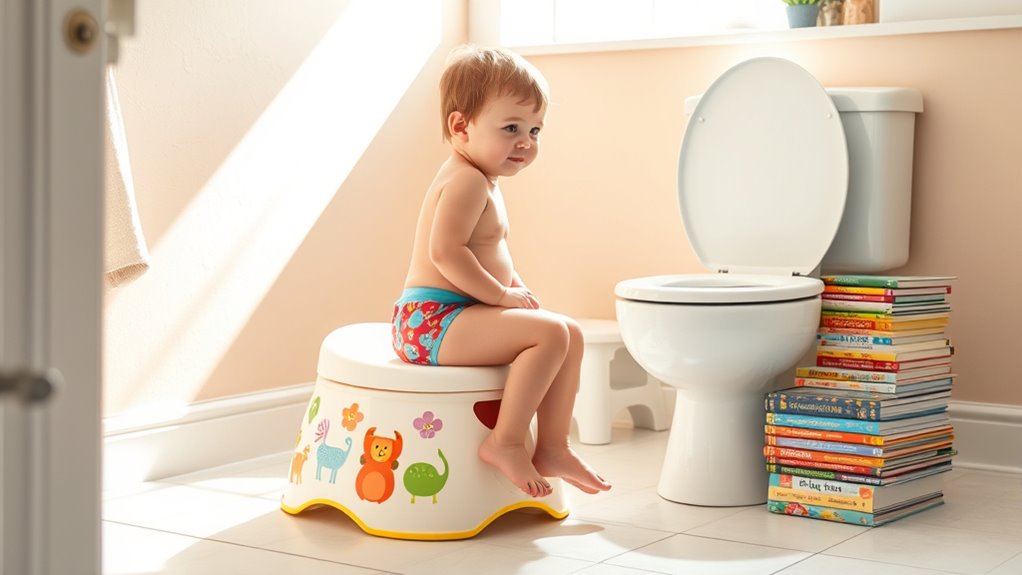
Starting the potty training process can feel overwhelming, but breaking it down into manageable steps makes it easier.
First, set up a comfortable potty chair or toilet insert with a stepstool. Choose appealing underwear to engage your child and keep extra clothing handy for accidents.
Set up a cozy potty chair or insert, and pick fun underwear to keep your child excited and prepared for accidents.
Establish a routine by taking frequent trips to the potty, especially after meals and naps, and consider using a timer. Demonstrate how to use the potty with a doll to enhance understanding.
Encourage your child to communicate their needs verbally, and remember to praise and reward successful attempts.
Finally, create a supportive environment by maintaining consistency and keeping the process positive and fun. This approach will set the stage for successful potty training.
Common Challenges and Solutions

Even with effective steps in place, potty training can present challenges that may catch you off guard. Many children experience anxiety or outright refusal to use the potty. Some might hold back from pooing or only feel comfortable doing so in their diapers.
Regular accidents are normal, but fear of the toilet’s noise or appearance can hinder progress. Additionally, fear of flushing poses another significant obstacle.
Emotional readiness matters; if your child resists, it might be wise to pause training. Establishing a consistent routine and using positive reinforcement can help ease anxiety.
If constipation or developmental delays arise, consult a healthcare professional. With patience and understanding, you can navigate these challenges successfully.
Tips for Maintaining Progress and Encouragement
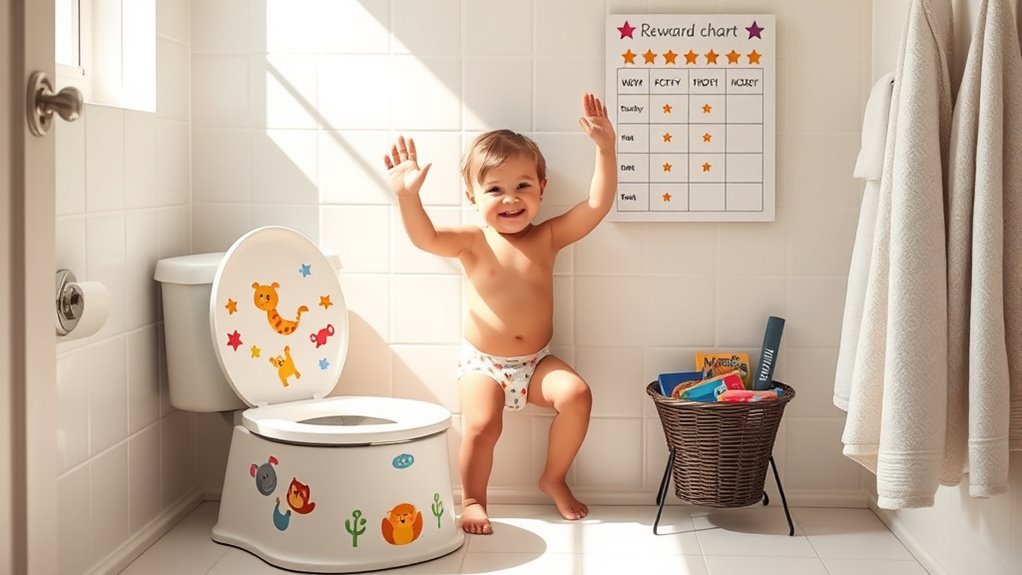
To maintain progress and encourage your child during potty training, it’s essential to create a supportive environment that celebrates their achievements, no matter how small.
Keep a positive attitude and avoid scolding for accidents; they’re part of the learning process. Use consistent vocabulary for bodily functions to reduce confusion. Reward successes with stickers or small treats, and make potty time fun with books or toys.
Allow your child to choose their own underwear to foster participation. Track their progress with a chart, and remember, it’s about progress, not perfection.
Be patient and maintain consistency across caregivers to reinforce learning. Finally, expect setbacks but stay calm; they’re natural as your child gains confidence and autonomy.
Frequently Asked Questions
What Should I Do if My Child Refuses to Use the Potty?
If your child refuses to use the potty, it’s essential to understand their feelings. Acknowledge their fears and avoid forcing them, as this can increase resistance.
Create a calm, supportive environment and consider offering choices like their own potty seat. Establish a routine and make it fun with songs or toys.
If they continue to resist, it might be best to take a break and try again later when they’re more comfortable.
Is It Normal for Potty Training to Take Several Months?
Absolutely, it’s normal for potty training to take several months!
Many parents find that their children need time to adjust to this new skill. Each child is unique, so don’t stress if it takes longer than you expected.
Stay patient and supportive, and remember that accidents are part of the learning process.
How Do I Handle Potty Training During Travel?
When you’re traveling, handling potty training can be tricky. Plan ahead by ensuring your child’s familiar with the process before the trip.
Bring a portable potty and pack extra clothing and wipes for accidents. Make frequent stops for breaks, and don’t hesitate to use pull-ups for convenience.
Keep your child motivated with rewards, and stay calm during any regressions. With preparation, you can make travel smoother for both of you.
Can I Use Rewards for Successful Potty Training?
Absolutely, you can use rewards for successful potty training! Immediate and consistent rewards reinforce the behavior, making it more likely your child will repeat it.
Choose rewards that your child finds appealing, like stickers or small treats.
Just remember to phase out the rewards gradually as they get used to the routine.
What if My Child Has Frequent Accidents After Training?
Every little one has their “oops” moments, and that’s perfectly normal!
If your child’s having frequent accidents after training, don’t fret. Stay calm and encourage them, as accidents can be learning opportunities.
Check for distractions or stressors in their life that might be causing this. Regular practice and open communication about their needs can help too.
Conclusion
To sum up, potty training can feel like a rollercoaster ride, with its ups and downs, but with patience and understanding, you’ll both get through it. Trust your instincts and remember that every child is different. Celebrate the small victories, and don’t hesitate to seek help if challenges arise. With the right approach and encouragement, your child will be using the potty like a pro before you know it. Keep the faith, and enjoy this exciting journey together!
